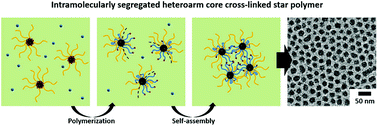当前位置:
X-MOL 学术
›
Polym. Chem.
›
论文详情
Our official English website, www.x-mol.net, welcomes your feedback! (Note: you will need to create a separate account there.)
Synthetic route-dependent intramolecular segregation in heteroarm core cross-linked star polymers as Janus-like nanoobjects†
Polymer Chemistry ( IF 4.6 ) Pub Date : 2019-10-09 , DOI: 10.1039/c9py00947g Nam Young Ahn 1, 2, 3, 4 , Myungeun Seo 1, 2, 3, 4, 5
Polymer Chemistry ( IF 4.6 ) Pub Date : 2019-10-09 , DOI: 10.1039/c9py00947g Nam Young Ahn 1, 2, 3, 4 , Myungeun Seo 1, 2, 3, 4, 5
Affiliation

|
Heteroarm core cross-linked star (CCS) polymers consist of two different polymer chains covalently joined to a cross-linked core. We investigated their self-assembly behavior to understand whether intramolecular segregation can be induced during synthesis, to produce spatial domains enriched with each polymer, and whether they would exhibit well-defined microphase separation morphologies as a result. Heteroarm CCS polymers containing polylactide (PLA) and polystyrene (PS) arms were synthesized by reversible addition–fragmentation chain transfer copolymerization of styrene and 1,2-bis(maleimidoethane) in the presence of a PLA-macro chain transfer agent (PLA-CTA), followed by chain extension with styrene (the in–out route). Dynamic light scattering, transmission electron microscopy, and small angle X-ray scattering analyses were employed to examine the self-assembly behavior in toluene and acetonitrile, as a relatively neutral and a PLA-selective solvent, respectively. Above a critical PS molar mass, lamellar-like and spherical morphologies were observed, formed by microphase separation into discrete PLA and PS domains. The increase in order with increasing PS molar mass was consistent with the segregation strength-dependent microphase separation behavior. In contrast, when the CCS polymer was synthesized by simultaneously joining PLA and PS chains (the multi macroinitiatior route) it produced rather ill-defined self-assemblies, suggesting that styrene chain extension via the in–out process is important to achieve intramolecular segregation. Using the more PLA-selective acetonitrile as a polymerization solvent indeed produced more well-defined supermicelles with PS cores and PLA coronas, confirming that intramolecular segregation can be driven by the incompatibility of the growing PS to the intramolecular environment, including PLA and the solvent.
中文翻译:

异臂核心交联星形聚合物中合成途径依赖的分子内分离,如Janus样纳米物体†
杂臂核交联星(CCS)聚合物由共价结合到交联核的两条不同的聚合物链组成。我们研究了它们的自组装行为,以了解在合成过程中是否可以诱导分子内偏析,产生富含每种聚合物的空间域,以及它们是否因此表现出明确的微相分离形态。在PLA-宏链转移剂(PLA-CTA)存在下,通过苯乙烯与1,2-双(马来酰亚胺基乙烷)的可逆加成-断裂链转移共聚反应,合成了包含聚丙交酯(PLA)和聚苯乙烯(PS)臂的异质CCS聚合物。 ),然后用苯乙烯进行扩链(进出途径)。动态光散射,透射电子显微镜,分别使用X射线和小角度X射线散射分析法检测甲苯和乙腈(分别为相对中性和PLA选择性溶剂)中的自组装行为。在临界PS摩尔质量以上,观察到由微相分离形成离散的PLA和PS域的层状和球形形态。随着PS摩尔质量的增加顺序增加与偏析强度相关的微相分离行为一致。相反,当通过同时连接PLA和PS链(多大分子引发途径)合成CCS聚合物时,它会产生非常不确定的自组装,表明苯乙烯链的延伸 观察到层状和球形形态,通过微相分离形成离散的PLA和PS域。随着PS摩尔质量的增加顺序增加与偏析强度相关的微相分离行为一致。相反,当通过同时连接PLA和PS链(多大分子引发途径)合成CCS聚合物时,它会产生非常不确定的自组装,表明苯乙烯链的延伸 观察到层状和球形形态,通过微相分离形成离散的PLA和PS域。随着PS摩尔质量的增加顺序增加与偏析强度相关的微相分离行为一致。相反,当通过同时连接PLA和PS链(多大分子引发途径)合成CCS聚合物时,它会产生非常不确定的自组装,表明苯乙烯链的延伸通过进出过程对于实现分子内分离很重要。使用更多具有PLA选择性的乙腈作为聚合溶剂确实会产生带有PS核和PLA电晕的定义更明确的超胶束,证实分子内偏析可以由生长中的PS与分子内环境(包括PLA和溶剂)的不相容性驱动。
更新日期:2020-01-02
中文翻译:

异臂核心交联星形聚合物中合成途径依赖的分子内分离,如Janus样纳米物体†
杂臂核交联星(CCS)聚合物由共价结合到交联核的两条不同的聚合物链组成。我们研究了它们的自组装行为,以了解在合成过程中是否可以诱导分子内偏析,产生富含每种聚合物的空间域,以及它们是否因此表现出明确的微相分离形态。在PLA-宏链转移剂(PLA-CTA)存在下,通过苯乙烯与1,2-双(马来酰亚胺基乙烷)的可逆加成-断裂链转移共聚反应,合成了包含聚丙交酯(PLA)和聚苯乙烯(PS)臂的异质CCS聚合物。 ),然后用苯乙烯进行扩链(进出途径)。动态光散射,透射电子显微镜,分别使用X射线和小角度X射线散射分析法检测甲苯和乙腈(分别为相对中性和PLA选择性溶剂)中的自组装行为。在临界PS摩尔质量以上,观察到由微相分离形成离散的PLA和PS域的层状和球形形态。随着PS摩尔质量的增加顺序增加与偏析强度相关的微相分离行为一致。相反,当通过同时连接PLA和PS链(多大分子引发途径)合成CCS聚合物时,它会产生非常不确定的自组装,表明苯乙烯链的延伸 观察到层状和球形形态,通过微相分离形成离散的PLA和PS域。随着PS摩尔质量的增加顺序增加与偏析强度相关的微相分离行为一致。相反,当通过同时连接PLA和PS链(多大分子引发途径)合成CCS聚合物时,它会产生非常不确定的自组装,表明苯乙烯链的延伸 观察到层状和球形形态,通过微相分离形成离散的PLA和PS域。随着PS摩尔质量的增加顺序增加与偏析强度相关的微相分离行为一致。相反,当通过同时连接PLA和PS链(多大分子引发途径)合成CCS聚合物时,它会产生非常不确定的自组装,表明苯乙烯链的延伸通过进出过程对于实现分子内分离很重要。使用更多具有PLA选择性的乙腈作为聚合溶剂确实会产生带有PS核和PLA电晕的定义更明确的超胶束,证实分子内偏析可以由生长中的PS与分子内环境(包括PLA和溶剂)的不相容性驱动。



























 京公网安备 11010802027423号
京公网安备 11010802027423号